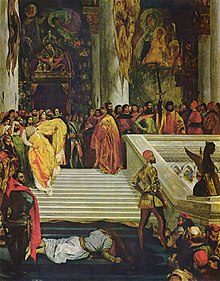
- https://en.wikipedia.org/wiki/Marino_Faliero
- Painted in 1825-6, a period when Delacroix briefly shared his studio with Bonington, whose influence this painting reveals. It was exhibited at the Paris Salon of 1827. The subject is taken, with some variations from the text, from Byron’s 'Marino Faliero, Doge of Venice' (1820), V, iv. Byron, with Walter Scott, was the modern author who provided the richest stimulation to Delacroix's work. Faliero (1274-1355) was elected Doge in 1354 but was executed in the following year after conspiring against the Venetian state. The setting in Delacroix's painting recalls (but does not represent) the Giant’s Staircase of the Doge’s Palace (built 1485-9), and the costumes, some of the heads of the dignitaries and the rich colouring are derived from Venetian Renaissance painting. The elderly bearded man at the top of the stairs, for example, is based on Titian's 'Self-Portrait' in Berlin. The picture was a favourite of Delacroix himself. Alexandre Dumas père said that Delacroix estimated it higher than any other of his works. The painting's lack of a strong moral message upset some contemporary critics.
2017年10月7日 星期六
The Execution of Marino Faliero, by Eugène Delacroix (1827, Wallace Collection).
訂閱:
張貼留言 (Atom)
沒有留言:
張貼留言